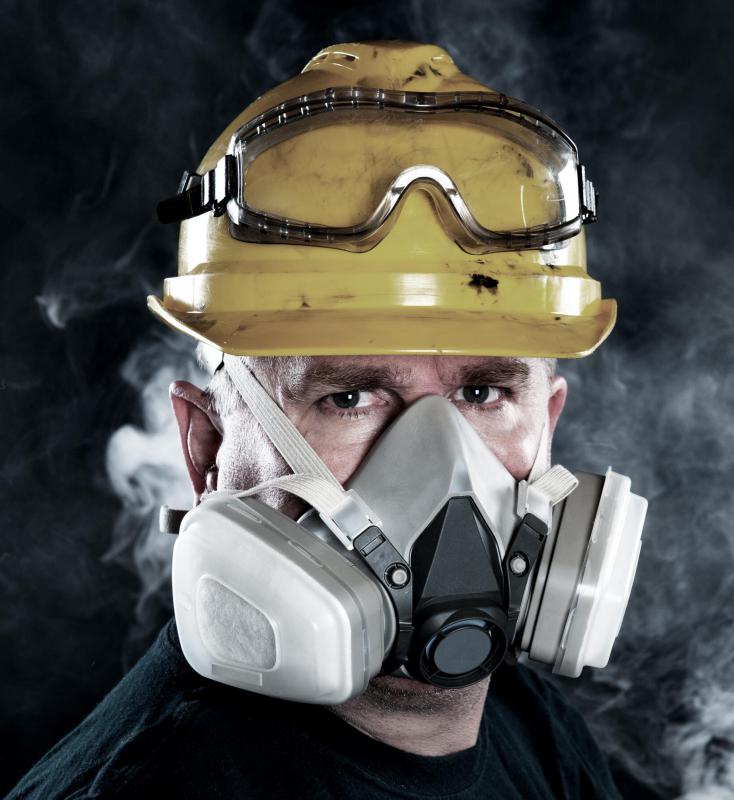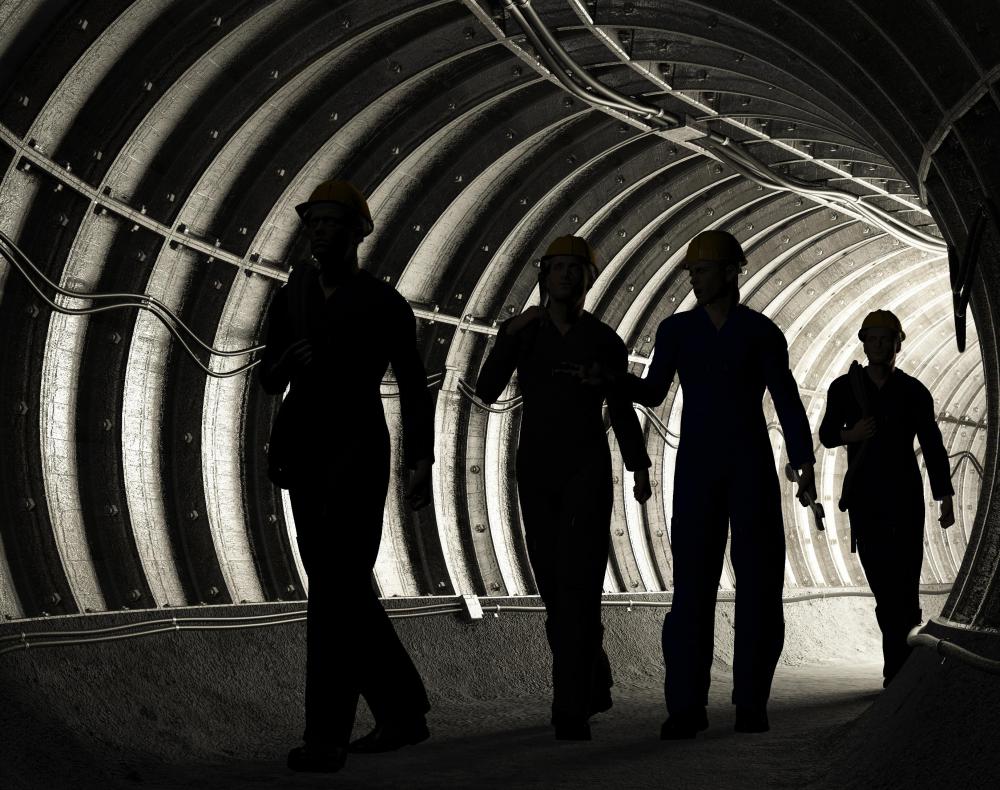At PracticalAdultInsights, we're committed to delivering accurate, trustworthy information. Our expert-authored content is rigorously fact-checked and sourced from credible authorities. Discover how we uphold the highest standards in providing you with reliable knowledge.
What does a Coal Miner do?
A coal miner can perform a number of tasks around a coal mine, depending on the type of mine where he or she works. Despite significant safety improvements, coal mining continues to be an extremely dangerous occupation, and no matter what kind of work a coal miner does, it's necessary to be physically fit in addition to being attentive and cautious. Being aware of the surroundings in a mine can save lives, making alertness an important part of the job description for miners.
In surface mining operations, a coal miner can operate the heavy equipment which is used to strip away the topsoil from a seam of coal, drill holes in the coal for the placement of explosives, or work as a blaster, setting explosive charges to break up coal seams so that they can be removed. Other coal miners in surface operations work with the equipment which is used to remove the coal loosened by blasting operations. Coal miners usually train to do this work on the job, although some mining companies offer classroom training opportunities as well as practice opportunities in a non-working mine so that miners can get comfortable with the work.

When a company needs to mine underground to access coal, a coal miner can be part of the crew which lays out the mine and provides reinforcement and support to prevent collapses. He or she can also work on the teams which actually break up and remove the coal, using heavy equipment rather than the iconic shovels many people associate with coal mining. Coal miners can also work as safety inspectors, making sure that conditions in the mine are safe and addressing safety concerns as they arise.

A skilled coal miner can work as a supervisor, overseeing work by other employees. Working as a supervisor can be less dangerous because supervisors are not necessarily in the thick of the work, but it also comes with major responsibilities, as supervisors must look out for the safety of the employees who work for them.
Coal mining is very dirty work, and it exposes people to a number of risks. Inhaled coal dust can cause lung problems, for example, and miners can be injured by heavy equipment, vehicle collisions, explosions, gas leaks, and collapses. Many coal miners are unionized so that they can enjoy more protections as workers and so that they can access assistance from the union if they are injured and need medical, legal, or financial help.
AS FEATURED ON:
AS FEATURED ON:

















Discussion Comments
My grandparents were born and raised in England, in a small coal mining town. A couple of years ago I had the chance to visit the place, and I actually went to the mine where most of the village men worked at one point in history.
Of course the mine has been closed for a long time, instead they have built a museum on the site. It was interesting to see pictures of past coal miners and memorabilia like a coal miner's lamp and the carts they used to fill, but a little bittersweet.
Further research revealed the social impact of such closures, including massive unemployment and extended families breaking up and scattering. I was glad that my relatives were not around to see how their beloved community had changed.
@lonelygod - I remember reading about the miners stranded underground in Chile, too. They were mining gold and copper, but mining in tunnels is still mining in tunnels.
I agree that safety for workers should be the highest priority, but unfortunately coal mining is a business, and like any business the highest thing on the coal mining companies' priority list is making more money.
Safety measures and extra insurance cost a lot. Infuriating and tragic as it is for the workers and their families, this means that many companies would rather stick with older mining techniques -- such as sending people deep down into tunnels -- rather than pay to revamp their whole work process to be safer.
I'm not saying it's right, or smart, but that's how it is. And each country has their own laws for how many precautions a mining business is required to make, so working as a miner in a country like Chile is probably much more dangerous than working as a miner in the United States.
Not to say that it's the fault of the country itself -- often the individual mining company is to blame for lack of safety regulations.
Case in point: that mining company that employed the workers in Chile who got stuck for two months underground? It's a company notorious for not complying to regulation, and for having many worker casualties.
@ahain - Cold-water slurry is definitely a big advancement in the use of coal. Did you know that not only does it make the coal produce much less emissions, but it also makes the processing area pretty much explosion proof?
Traditional coal processing methods involve crushing the coal into powder and tiny bits before burning it. Like flour, these particles can sometimes get so thick in the air that they can explode and cause serious damage -- especially if the explosion reaches the rest of the coal in the room!
With the cold-water slurry technique, the powder is all wet and contained in the water, so it's actually much safer than traditional coal mining.
As if that's not enough incentive to switch to cold-water slurry techniques, the process is so cheap that production produces a lot less overhead costs -- so the resulting diesel fuel replacement costs at least thirty percent less than diesel does --- up to seventy percent, depending on the location.
So cold-water slurry coal techniques are better for the environment, cheaper for everybody, and create a better working environment for the coal miners -- what's not to like?
@wander - Indeed, coal mining is more technologically advanced, but it's definitely still a big business! In fact, according to a lecturer who recently spoke at my college, coal is currently the biggest source of power in the world. Yes, even bigger than fossil fuels, wind power, tidal power and nuclear power.
Because people tend to think of coal mining as an old-time kind of activity and an old-fashioned method of getting power, the average person -- at least the average person in the United States, where I live -- they don't talk about it as much as any of those other power methods, though. Instead they think of just what the article talks about -- the iconic shovels and a time they talk about as "back in the coal miner days."
The traditional method of extracting power out of coal -- burning it and using the steam it creates to turn turbines and create electricity -- isn't very environmentally friendly. Because coal is almost entirely made of carbon, you can image the "carbon footprint" isn't great.
Thankfully, just as the coal mining process has become more advanced, so has the processing method. There is now a method of using coal called "cold water slurry" that involves mixing coal bits up with water instead of burning it. It apparently can replace diesel fuel and is much better for the environment than traditional coal-burning methods.
Isn't technology great?
When I was reading about what coal miners do, it reminded me of the news story from 2010 about the Chilean miners that were trapped in their underground mine for more than two months. All mining work is a dangerous job, and I feel that operators should make more effort to ensure that the working conditions of these people are safe.
In the case of the Chilean miners there mine collapsed because of an avalanche of rock. I wonder how many mines this has happened to other mines?
If people are going to keep craving power from sources like coal, I think we need to ensure that the working environment is safe and that people are not endangering their lives to do it.
Coal miners can work both underground and above ground as there are many mines in the USA that use both methods to extract coal. It is believed though, that surface coal is not of the same quality of underground coal, leaving many companies to prefer the deep, dark mines that we always see in movies.
Nowadays the coal mining industry is shrinking, with fewer mines than there was a decade ago. Interestingly though, coal production has actually increased, even with fewer miners and mines, due to the improvement in extraction technology. On average the US uses about 14% of the world’s coal each year and produces 2587000 short tons daily.
Post your comments